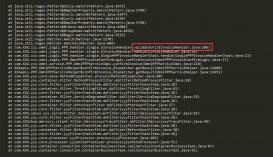一:抓取网页中的Email地址
利用正则表达式匹配网页中的文本
[\\w[.-]]+@[\\w[.-]]+\\.[\\w]+
将网页内容分割提取
|
1
2
3
4
5
6
7
8
9
10
11
12
13
14
15
16
17
18
19
20
21
22
23
24
25
26
27
28
|
import java.io.BufferedReader;import java.io.FileNotFoundException;import java.io.FileReader;import java.io.IOException;import java.util.regex.Matcher;import java.util.regex.Pattern;public class EmailSpider { public static void main(String[] args) { try { BufferedReader br = new BufferedReader(new FileReader("C:\\emailSpider.html")); String line = ""; while((line=br.readLine()) != null) { parse(line); } } catch (FileNotFoundException e) { e.printStackTrace(); } catch (IOException e) { e.printStackTrace(); } } private static void parse(String line) { Pattern p = Pattern.compile("[\\w[.-]]+@[\\w[.-]]+\\.[\\w]+"); Matcher m = p.matcher(line); while(m.find()) { System.out.println(m.group()); } }} |
打印结果:
867124664@qq.com
260678675@QQ.com
806208721@qq.com
hr_1985@163.com
32575987@qq.com
qingchen0501@126.com
yingyihanxin@foxmail.com
1170382650@qq.com
1170382650@qq.com
yingyihanxin@foxmail.com
qingchen0501@126.com
32575987@qq.com
hr_1985@163.com
现在你找到这么多邮箱地址,用上JavaMail的知识,你可以群发垃圾邮件了,呵呵!!!
二:代码统计
|
1
2
3
4
5
6
7
8
9
10
11
12
13
14
15
16
17
18
19
20
21
22
23
24
25
26
27
28
29
30
31
32
33
34
35
36
37
38
39
40
41
42
43
44
45
46
47
48
49
50
51
52
53
54
55
56
57
58
59
60
61
62
63
64
65
66
67
68
69
70
71
72
|
import java.io.BufferedReader;import java.io.File;import java.io.FileNotFoundException;import java.io.FileReader;import java.io.IOException;public class CodeCounter { static long normalLines = 0;//正常代码行 static long commentLines = 0;//注释行 static long whiteLines = 0;//空白行 public static void main(String[] args) { //找到某个文件夹,该文件夹下面在没有文件夹,这里没有写递归处理不在同一文件夹的文件 File f = new File("E:\\Workspaces\\eclipse\\Application\\JavaMailTest\\src\\com\\java\\mail"); File[] codeFiles = f.listFiles(); for(File child : codeFiles){ //只统计java文件 if(child.getName().matches(".*\\.java$")) { parse(child); } } System.out.println("normalLines:" + normalLines); System.out.println("commentLines:" + commentLines); System.out.println("whiteLines:" + whiteLines); } private static void parse(File f) { BufferedReader br = null; //表示是否为注释开始 boolean comment = false; try { br = new BufferedReader(new FileReader(f)); String line = ""; while((line = br.readLine()) != null) { //去掉注释符/*前面可能出现的空白 line = line.trim(); //空行 因为readLine()将字符串取出来时,已经去掉了换行符\n //所以不是"^[\\s&&[^\\n]]*\\n$" if(line.matches("^[\\s&&[^\\n]]*$")) { whiteLines ++; } else if (line.startsWith("/*") && !line.endsWith("*/")) { //统计多行/*****/ commentLines ++; comment = true; } else if (line.startsWith("/*") && line.endsWith("*/")) { //统计一行/**/ commentLines ++; } else if (true == comment) { //统计*/ commentLines ++; if(line.endsWith("*/")) { comment = false; } } else if (line.startsWith("//")) { commentLines ++; } else { normalLines ++; } } } catch (FileNotFoundException e) { e.printStackTrace(); } catch (IOException e) { e.printStackTrace(); } finally { if(br != null) { try { br.close(); br = null; } catch (IOException e) { e.printStackTrace(); } } } }} |
以上内容就是本文给大家分享的Java在正则表达式的使用,希望大家喜欢。













